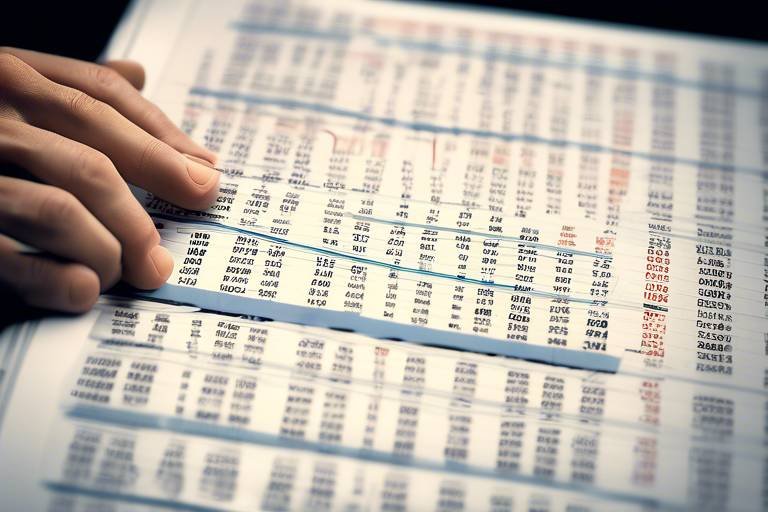Strategies for Trading Cryptocurrency with Technical Indicators
In the fast-paced world of cryptocurrency trading, having a solid game plan can make all the difference. With prices fluctuating like a rollercoaster, how do you make sense of it all? Enter technical indicators—the trusty sidekicks of traders everywhere. These tools help you analyze market trends and price movements, allowing you to make informed decisions rather than relying on gut feelings. Think of them as your personal market detectives, revealing hidden patterns and signals that can guide your trading strategies.
When you dive into the realm of technical indicators, it's essential to grasp their significance. They provide a visual representation of market sentiment and price dynamics, helping traders identify potential entry and exit points. Whether you're a seasoned trader or just starting, understanding how to effectively utilize these indicators can elevate your trading game. But, how do you choose the right indicators? And how do you interpret them to craft your strategies? Let's break it down!
Technical indicators are mathematical calculations based on the price, volume, or open interest of a security. They are used to forecast future price movements and help traders make decisions. The beauty of these indicators lies in their ability to simplify complex data into digestible information. By analyzing charts filled with indicators, traders can spot trends, reversals, and potential breakout opportunities.
Imagine walking into a crowded room filled with noise. It’s hard to focus, right? Now, picture wearing noise-canceling headphones that filter out the chaos. That’s what technical indicators do—they help you cut through the noise of the market and focus on what truly matters. Each indicator has its unique purpose and function, and knowing how to leverage them can give you a significant edge in your trading endeavors.
Among the plethora of technical indicators available, some stand out as the most commonly used in cryptocurrency trading. These include Moving Averages, Relative Strength Index (RSI), and Moving Average Convergence Divergence (MACD). Each of these indicators serves a specific purpose and can be integral to your trading strategy.
For instance, Moving Averages help smooth out price data to identify trends over time. This means you can spot whether the market is moving upward, downward, or sideways. The RSI, on the other hand, measures the speed and change of price movements, giving you insights into whether an asset is overbought or oversold. By mastering these indicators, you can make more informed trading decisions that align with market trends.
Moving Averages are like the compass of your trading journey. They help you navigate through the turbulent waters of price fluctuations. By averaging a set number of past prices, they reveal the overall direction of the market. There are two primary types of Moving Averages: the Simple Moving Average (SMA) and the Exponential Moving Average (EMA).
The Simple Moving Average is calculated by taking the average of a specified number of past prices. For example, if you’re looking at a 10-day SMA, you add up the closing prices of the last ten days and divide by ten. This indicator is particularly useful for identifying support and resistance levels. When the price approaches the SMA, it often reacts, either bouncing off it or breaking through, signaling potential trading opportunities.
On the flip side, the Exponential Moving Average gives more weight to recent prices, making it more responsive to new information. This can be a game-changer for traders looking to capture short-term price movements. If you’re trading in a volatile market, the EMA can help you react quickly to changes, allowing you to seize opportunities before they vanish.
The Relative Strength Index (RSI) is another powerful tool in your trading arsenal. It measures the speed and change of price movements on a scale from 0 to 100. Typically, an RSI above 70 indicates that an asset is overbought, while an RSI below 30 suggests that it’s oversold. By keeping an eye on the RSI, traders can identify potential reversal points and make more strategic entry or exit decisions.
Now that you have a grasp of some essential indicators, let’s talk about the magic of combining them. Using multiple technical indicators together can enhance your trading strategies significantly. For example, pairing the RSI with Moving Averages can provide clearer buy and sell signals. When the RSI indicates an overbought condition while the price is above the moving average, it might be a strong signal to consider selling.
Combining RSI with Moving Averages can create a powerful trading strategy. When you see the RSI hitting an extreme level (either overbought or oversold), you can check the Moving Averages for confirmation. If both indicators align, your confidence in the trade increases. This synergy can lead to more accurate and timely trading decisions.
Another layer of analysis comes from integrating volume indicators. Volume indicators provide insights into market strength, helping you understand whether a price movement is backed by significant buying or selling pressure. By combining volume with other technical indicators, you can gain a deeper understanding of market dynamics and make more informed trading decisions.
- What are technical indicators? Technical indicators are mathematical calculations based on price and volume data used to forecast future price movements.
- How do I choose the right indicators? It depends on your trading strategy, but commonly used indicators include Moving Averages, RSI, and MACD.
- Can I use multiple indicators at once? Yes! Combining indicators can enhance your trading strategy and provide clearer signals.

Understanding Technical Indicators
When it comes to trading cryptocurrencies, understanding technical indicators can be your secret weapon. These indicators are like the compass that guides you through the often turbulent waters of the crypto market. They help you make sense of price movements, identify trends, and ultimately make informed trading decisions. But what exactly are these indicators, and why are they so crucial?
Technical indicators are mathematical calculations based on the price and/or volume of a cryptocurrency. They can provide insights into market behavior that might not be immediately obvious just by looking at price charts. Think of them as the magnifying glass that allows you to see the finer details of market dynamics. By analyzing these indicators, traders can gain a better understanding of market sentiment, which can be pivotal in deciding when to buy or sell.
There are two main categories of technical indicators: leading indicators and lagging indicators. Leading indicators attempt to predict future price movements, while lagging indicators confirm trends after they have occurred. This distinction is crucial because it helps traders choose the right tools based on their trading strategies. For example, if you're looking to get ahead of the curve, leading indicators might be your go-to. On the other hand, if you prefer to confirm trends before making a move, lagging indicators could be more suitable.
In addition to understanding the types of indicators, it’s also important to recognize their limitations. No indicator is foolproof; they are merely tools to aid in decision-making. Relying solely on technical indicators without considering other factors, such as market news or fundamental analysis, can lead to poor trading decisions. Therefore, it's essential to use these indicators in conjunction with other analysis methods.
As you dive deeper into the world of cryptocurrency trading, you’ll find that mastering technical indicators can significantly enhance your trading strategies. Whether you're a novice or a seasoned trader, these tools can offer valuable insights that can help you navigate the complexities of the market. So, buckle up and get ready to explore the fascinating world of technical indicators!

Common Types of Technical Indicators
When diving into the world of cryptocurrency trading, understanding technical indicators is like having a map in uncharted territory. They are the tools that help traders navigate the often tumultuous waters of the market. Technical indicators can be categorized into several types, each serving a unique purpose in analyzing price movements and market trends. In this section, we will explore some of the most commonly used technical indicators that can significantly enhance your trading strategy.
One of the primary indicators that traders frequently rely on is the Moving Average. This indicator smooths out price data to help identify trends over time. By filtering out the "noise" of price fluctuations, moving averages allow traders to see the bigger picture. There are two main types of moving averages: the Simple Moving Average (SMA) and the Exponential Moving Average (EMA). Each has its own strengths and weaknesses, which can cater to different trading styles.
Another crucial indicator is the Relative Strength Index (RSI). This momentum oscillator measures the speed and change of price movements, providing insights into whether a cryptocurrency is overbought or oversold. An RSI reading above 70 typically indicates that an asset may be overbought, while a reading below 30 suggests it may be oversold. Understanding the RSI can help traders time their entries and exits more effectively.
Moreover, traders often utilize Volume Indicators to gauge the strength of price movements. Volume indicators reveal how many units of a cryptocurrency have been traded over a specific period. High trading volume can signify strong interest in a particular asset, while low volume may indicate a lack of commitment from traders. Integrating volume data with other technical indicators can lead to more informed trading decisions.
To summarize, here’s a quick overview of some of the most commonly used technical indicators in cryptocurrency trading:
| Indicator | Description | Application |
|---|---|---|
| Moving Averages (SMA & EMA) | Smooth out price data to identify trends | Used for spotting support and resistance levels |
| Relative Strength Index (RSI) | Measures speed and change of price movements | Identifies overbought or oversold conditions |
| Volume Indicators | Indicates the strength of price movements | Helps in confirming trends and reversals |
By familiarizing yourself with these indicators, you'll be better equipped to make informed trading decisions in the fast-paced cryptocurrency market. Remember, the key to successful trading lies not just in knowing these tools but in understanding how to apply them effectively in various market conditions.
What are technical indicators?
Technical indicators are mathematical calculations based on historical price and volume data, used to forecast future price movements in financial markets.
How do I choose the right indicator?
The right indicator depends on your trading style and strategy. For instance, day traders might prefer short-term indicators like the EMA, while long-term investors might focus on the SMA.
Can I use multiple indicators at once?
Absolutely! Many traders combine multiple indicators to confirm signals and improve their trading accuracy.
Are technical indicators foolproof?
While technical indicators can provide valuable insights, they are not infallible. Always consider market conditions and use them in conjunction with other analysis methods.

Moving Averages
When diving into the world of cryptocurrency trading, one of the first tools you'll likely encounter is the Moving Average. It's like having a trusty compass in the often chaotic seas of the crypto market. But what exactly are Moving Averages, and how can they help you navigate your trading journey? In essence, Moving Averages smooth out price data over a specified period, making it easier to identify trends and potential reversals. They act as a filter, helping traders to distinguish between the noise of daily price fluctuations and the underlying direction of the market.
There are two primary types of Moving Averages that traders often rely on: the Simple Moving Average (SMA) and the Exponential Moving Average (EMA). Each of these has its unique characteristics and applications, which can significantly influence your trading decisions.
The Simple Moving Average is calculated by taking the arithmetic mean of a set number of past prices. For instance, if you wanted to calculate a 10-day SMA, you would add up the closing prices for the last ten days and then divide by ten. This straightforward approach can help you identify key support and resistance levels. However, one downside is that it can lag behind current price movements, which may not always provide the most timely signals.
On the other hand, the Exponential Moving Average gives more weight to recent prices, making it more responsive to new information. This characteristic can be particularly advantageous for traders looking to capture short-term price movements. For example, if you're trading on a 5-minute chart, using the EMA can help you react faster to price changes, allowing for quicker entry and exit points in your trades.
| Type of Moving Average | Calculation Method | Use Case |
|---|---|---|
| Simple Moving Average (SMA) | Arithmetic mean of past prices | Identifying support and resistance levels |
| Exponential Moving Average (EMA) | Weighted average that prioritizes recent prices | Capturing short-term price movements |
Ultimately, the choice between SMA and EMA often comes down to your trading style and objectives. If you're a long-term trader, the SMA might serve you well in identifying broader trends. However, if you're looking to capitalize on short-term fluctuations, the EMA could be your best bet. It's essential to experiment with both types to see which aligns best with your trading strategy.
In conclusion, Moving Averages are invaluable tools in the arsenal of any cryptocurrency trader. They not only help in identifying trends but also provide a clearer picture of market sentiment. By understanding and utilizing both SMA and EMA, you can enhance your trading decisions and potentially increase your profitability in the vibrant world of cryptocurrency.
- What is the main difference between SMA and EMA? The SMA gives equal weight to all prices in the selected period, while the EMA gives more weight to recent prices, making it more responsive to new information.
- How can I determine which Moving Average to use? It depends on your trading strategy. For long-term trends, SMA may be better; for short-term trades, EMA is often preferred.
- Can Moving Averages be used in isolation? While they are useful, it's generally better to combine Moving Averages with other indicators to confirm signals and improve trading accuracy.

Simple Moving Average (SMA)
The is a fundamental tool in the arsenal of any cryptocurrency trader. It’s like a compass that helps you navigate the turbulent waters of market volatility. By calculating the average price of a cryptocurrency over a specified number of periods, the SMA provides a clear view of the underlying trend. For instance, if you're looking at a 10-day SMA, it takes the closing prices of the past ten days, adds them together, and then divides by ten. This smooths out the noise and helps traders see the bigger picture.
One of the key benefits of using the SMA is its ability to identify support and resistance levels. When the price of a cryptocurrency consistently bounces off the SMA, it indicates a strong support level. Conversely, if the price struggles to break through the SMA, it often signifies a resistance level. This can be incredibly useful for traders looking to make informed decisions about when to enter or exit a position.
To illustrate how the SMA works, let’s take a look at a simple table that breaks down the calculations:
| Day | Closing Price |
|---|---|
| 1 | $100 |
| 2 | $110 |
| 3 | $105 |
| 4 | $115 |
| 5 | $120 |
| 6 | $125 |
| 7 | $130 |
| 8 | $128 |
| 9 | $135 |
| 10 | $140 |
In this example, to calculate the 10-day SMA, you’d add all the closing prices and divide by 10. This gives you a clearer indication of the average price over that period, allowing you to make more strategic trading decisions.
However, it’s important to note that while the SMA is a powerful tool, it does have its limitations. Since it relies on historical data, it can lag behind current market conditions. This means that traders might miss out on significant price movements if they solely rely on the SMA. Therefore, it’s often beneficial to use the SMA in conjunction with other indicators, such as the Exponential Moving Average (EMA) or the Relative Strength Index (RSI), to create a more comprehensive trading strategy.
Ultimately, the SMA is like a safety net for traders. It helps you avoid the pitfalls of emotional trading by providing a clear, data-driven perspective on market trends. By incorporating the SMA into your trading toolkit, you can enhance your ability to make informed decisions and navigate the often unpredictable world of cryptocurrency trading.

Exponential Moving Average (EMA)
The is a powerful tool in the arsenal of cryptocurrency traders, primarily because it emphasizes the most recent price data. Unlike the Simple Moving Average (SMA), which treats all price points equally, the EMA gives greater weight to the latest prices, making it more responsive to recent market movements. This characteristic allows traders to capture short-term price fluctuations more effectively, which can be crucial in the fast-paced world of cryptocurrency trading.
One of the key benefits of using the EMA is its ability to provide a clearer picture of the current market trend. For instance, when the price of a cryptocurrency is above the EMA, it often indicates a bullish trend, while a price below the EMA may suggest a bearish trend. This can help traders make quick decisions about when to enter or exit a position. Moreover, the EMA can be customized to different time frames, allowing traders to adapt their strategies based on their trading style—whether they are day trading, swing trading, or investing for the long term.
To fully appreciate the utility of the EMA, it’s beneficial to understand how it is calculated. The formula for the EMA is:
EMA (Current Price x (k)) + (Previous EMA x (1 - k)) Where: k 2 / (N + 1) N number of periods
This formula illustrates how the EMA smooths out price data while still reacting to recent price changes. As a trader, you might find it useful to experiment with different periods for the EMA. For example, a 12-day EMA can be used for short-term trading, while a 26-day EMA might be more suitable for longer-term trends. By observing how these different EMAs interact with each other, traders can identify potential buy and sell signals.
Another important aspect of the EMA is its role in conjunction with other indicators. For example, when the EMA crosses above the SMA, it can be seen as a bullish signal, while a crossover below may indicate a bearish trend. This interplay between the EMA and other indicators can provide a more comprehensive view of market conditions, enhancing your trading strategy.
In summary, the Exponential Moving Average is not just a number; it’s a dynamic tool that can significantly enhance your trading strategy. By focusing on recent price movements and providing timely signals, the EMA helps traders navigate the often volatile waters of cryptocurrency markets with greater confidence.
- What is the main difference between EMA and SMA? The main difference lies in their calculation methods: EMA gives more weight to recent prices, making it more responsive to market changes compared to SMA.
- How do I choose the right period for EMA? The choice of period depends on your trading style; shorter periods like 12 or 9 days are better for day trading, while longer periods like 26 days are more suitable for longer-term analysis.
- Can I use EMA with other indicators? Absolutely! Combining EMA with other indicators like RSI or volume can provide more robust trading signals.
- Is EMA suitable for all cryptocurrencies? Yes, EMA can be applied to any cryptocurrency, but the effectiveness may vary based on the asset's volatility and trading volume.

Relative Strength Index (RSI)
The is a powerful momentum oscillator that measures the speed and change of price movements. Developed by J. Welles Wilder Jr., this technical indicator ranges from 0 to 100 and is primarily used to identify overbought or oversold conditions in a market. Traders often look for readings above 70 to indicate that an asset might be overbought, while readings below 30 suggest it could be oversold. But why is this important? Well, understanding these conditions can help traders make more informed decisions about when to enter or exit a trade.
Imagine you're at a carnival, and you see a game where you can win a giant teddy bear. The longer you watch, the more you notice that everyone is winning—until suddenly, a few players start losing. This is akin to the RSI; when the game is consistently producing winners (or when the price is consistently rising), it might be time to step back and reassess. Just like in the carnival, if everyone is winning, it might indicate that the game is about to change. The RSI serves as your warning sign, alerting you to potential reversals in price trends.
One of the unique features of the RSI is its ability to highlight divergences. A divergence occurs when the price of an asset moves in one direction while the RSI moves in the opposite direction. For example, if the price is making new highs, but the RSI is failing to reach new highs, this might indicate a weakening trend. Such insights can be crucial for traders looking to capitalize on potential reversals. Let's take a look at a simple table that illustrates how to interpret RSI values:
| RSI Value | Market Condition |
|---|---|
| 0 - 30 | Oversold - potential buying opportunity |
| 30 - 50 | Neutral - wait for confirmation |
| 50 - 70 | Neutral - potential selling opportunity |
| 70 - 100 | Overbought - potential selling opportunity |
To effectively use the RSI in your trading strategy, consider combining it with other indicators. For instance, when the RSI indicates an oversold condition, you might want to look for confirmation from a moving average crossover. This multi-faceted approach can enhance your trading accuracy and help you make more informed decisions. Remember, while the RSI is a valuable tool, it’s essential to use it in conjunction with other indicators and analysis methods to get a complete picture of market conditions.
Q: What does an RSI value of 50 indicate?
A: An RSI value of 50 suggests a neutral market condition, indicating that there is no clear trend in either direction.
Q: Can the RSI be used for all cryptocurrencies?
A: Yes, the RSI can be applied to any cryptocurrency, but its effectiveness may vary based on market conditions and the specific asset.
Q: How often should I check the RSI?
A: It depends on your trading strategy. Day traders might check it more frequently, while long-term investors may look at it less often.

Combining Indicators for Better Insights
When it comes to trading cryptocurrency, relying on a single technical indicator can sometimes feel like trying to navigate a maze with only one eye open. The world of crypto is chaotic and ever-changing, and using a combination of indicators can provide a more comprehensive view of market trends. By integrating multiple technical indicators, traders can significantly enhance their analysis and make more informed decisions. Think of it as having a multi-tool in your trading toolkit; each tool serves a purpose and together they create a more powerful weapon against market volatility.
For instance, combining the Relative Strength Index (RSI) with Moving Averages can yield clearer buy and sell signals. The RSI indicates whether an asset is overbought or oversold, while Moving Averages help identify the overall trend direction. When these two indicators align, traders can gain confidence in their trading strategy. Imagine you're a sailor: the RSI is your compass, helping you determine if you should set sail (buy) or hold back (sell) based on the market's conditions, while Moving Averages are the stars guiding you through the waters of price trends.
Moreover, integrating volume indicators into your analysis can provide insights into market strength and the sustainability of price movements. Volume measures how much of a given asset is being traded, and when combined with other indicators, it can help confirm trends. For example, if the price is rising and the volume is also increasing, it suggests that the trend is strong and likely to continue. Conversely, if the price rises but volume declines, it may indicate a potential reversal. In this way, volume acts as a supporting actor in your trading strategy, ensuring that the main star—your chosen indicators—has the strength to carry the performance.
To effectively combine these indicators, traders should consider the following strategies:
- Look for Convergence: When multiple indicators point in the same direction, it can signal a strong trading opportunity.
- Use Confirmatory Signals: Wait for confirmation from one indicator before acting on another. For instance, if the RSI indicates overbought conditions, check if the Moving Average shows a downward trend before selling.
- Adjust Time Frames: Experiment with different time frames for each indicator to find the best combination that suits your trading style.
In conclusion, combining technical indicators is not just a strategy; it's a way to enhance your trading prowess. By blending the insights from various indicators, you can create a more robust trading plan that adapts to the dynamic nature of cryptocurrency markets. Remember, the goal is to equip yourself with the best tools available and to navigate the trading waters with confidence.
Q: What are technical indicators?
A: Technical indicators are mathematical calculations based on price and volume data used by traders to forecast future price movements.
Q: How do I choose which indicators to combine?
A: Start with indicators that complement each other, such as momentum indicators (like RSI) with trend indicators (like Moving Averages). Test different combinations to see what works best for your trading strategy.
Q: Can I rely solely on technical indicators for trading?
A: While technical indicators are valuable tools, it's essential to combine them with fundamental analysis and market news to make well-rounded trading decisions.

Using RSI with Moving Averages
Combining the Relative Strength Index (RSI) with Moving Averages can significantly enhance your trading strategy. Think of it as pairing two powerful tools to create a more comprehensive view of the market. The RSI gives you insights into whether a cryptocurrency is overbought or oversold, while Moving Averages help you identify the overall trend. When used together, they can provide clearer buy and sell signals, making your trading decisions more informed and strategic.
For instance, let’s say you’re observing a cryptocurrency that has been on a bullish trend, indicated by a rising Simple Moving Average (SMA). If the RSI simultaneously shows a value above 70, it suggests that the asset may be overbought. In this scenario, you might consider waiting for a correction before entering a position, or perhaps look for short selling opportunities. On the other hand, if the RSI is below 30 while the SMA is trending upwards, it could signal a potential buying opportunity, indicating that the asset is oversold despite the overall positive trend.
To utilize these indicators effectively, you can follow a few key strategies:
- Identify Divergence: Look for instances where the price is making new highs while the RSI is not. This divergence can signal a potential reversal.
- Crossovers: A bullish signal occurs when the price crosses above the Moving Average and the RSI rises above 50. Conversely, a bearish signal happens when the price drops below the Moving Average and the RSI falls below 50.
- Confirmation: Use the RSI to confirm signals generated by Moving Averages. For example, if your Moving Average indicates a buy signal, check if the RSI supports this by being below 30.
Incorporating these strategies into your trading plan can help you navigate the volatile world of cryptocurrency with greater confidence. Remember, however, that no indicator is foolproof. Always consider the broader market context and other factors before making a trading decision. This combination of indicators not only helps in identifying potential entry and exit points but also reduces the chances of making impulsive trades based on emotions.
What is the best combination of indicators for cryptocurrency trading?
While there’s no one-size-fits-all answer, many traders find success using RSI with Moving Averages, along with volume indicators for a more rounded analysis.
How do I know when to sell using RSI and Moving Averages?
Look for bearish signals such as when the price falls below a Moving Average while the RSI indicates overbought conditions (above 70). This can suggest a potential price drop.
Can I use these indicators on any cryptocurrency?
Absolutely! RSI and Moving Averages can be applied to any cryptocurrency, though their effectiveness may vary based on market conditions and the specific asset.

Integrating Volume Indicators
When it comes to cryptocurrency trading, understanding market strength is just as crucial as analyzing price movements. Volume indicators serve as a powerful tool that can provide traders with insights into the intensity of price movements. Think of volume as the heartbeat of the market; it shows how alive and active a particular asset is at any given moment. By integrating volume indicators with other technical analysis tools, traders can make more informed decisions that can significantly enhance their trading strategies.
One of the most popular volume indicators is the Volume Moving Average. This indicator smooths out volume fluctuations over a specified period, allowing traders to identify trends more easily. For instance, if the current volume surpasses the moving average, it may indicate a potential breakout or a strong trend. Conversely, if the volume is below the average, it could suggest a weakening trend. By monitoring these signals, traders can better time their entries and exits in the market.
Another effective volume indicator is the On-Balance Volume (OBV). This indicator uses volume flow to predict changes in stock price. The basic premise is simple: when the price goes up, the volume is added, and when the price goes down, the volume is subtracted. By analyzing the OBV, traders can detect bullish or bearish trends. For example, if the price is rising but the OBV is falling, it may be a sign that the rally lacks strength and could reverse soon.
Integrating volume indicators with other technical indicators can create a more comprehensive trading strategy. For instance, combining the Relative Strength Index (RSI) with volume indicators can help confirm whether a market is overbought or oversold. If the RSI indicates an overbought condition but the volume is low, it could mean that the upward momentum is weakening. This divergence can be a critical signal for traders looking to take profits or enter short positions.
Moreover, volume indicators can also assist in identifying support and resistance levels. High volume at certain price levels may indicate strong support or resistance, serving as psychological barriers for traders. For instance, if an asset consistently bounces back from a level with high volume, it may signal a strong support level worth considering for future trades. Conversely, if an asset breaks through a resistance level with increased volume, it may suggest a continuation of the upward trend.
In summary, integrating volume indicators into your trading strategy can provide a clearer picture of market dynamics. By combining these indicators with others, such as moving averages and RSI, traders can enhance their market analysis and decision-making processes. Remember, the key to successful trading lies not just in understanding price movements but also in gauging the strength behind those movements.
- What are volume indicators? Volume indicators are tools used in technical analysis to measure the strength of price movements in the market based on trading volume.
- How do I use volume indicators in trading? You can use volume indicators to confirm trends, identify potential reversals, and determine support and resistance levels.
- What is the On-Balance Volume (OBV)? OBV is a volume-based indicator that uses volume flow to predict changes in stock price, helping traders gauge market strength.
- Can volume indicators be used with other technical indicators? Yes, integrating volume indicators with other technical tools like RSI and moving averages can provide a more comprehensive analysis of market conditions.
Frequently Asked Questions
- What are technical indicators in cryptocurrency trading?
Technical indicators are mathematical calculations based on the price, volume, or open interest of a security or market. They help traders analyze market trends and make informed decisions by providing insights into potential price movements.
- How do I use Moving Averages in my trading strategy?
Moving Averages, such as Simple Moving Average (SMA) and Exponential Moving Average (EMA), are used to smooth out price data. Traders often look for crossovers between different Moving Averages to identify potential buy or sell signals. For instance, when a shorter-term EMA crosses above a longer-term SMA, it may indicate a bullish trend.
- What is the Relative Strength Index (RSI) and how is it useful?
The Relative Strength Index (RSI) is a momentum oscillator that measures the speed and change of price movements. It ranges from 0 to 100 and is typically used to identify overbought or oversold conditions. An RSI above 70 may suggest that a cryptocurrency is overbought, while an RSI below 30 may indicate it is oversold, helping traders make timely decisions.
- Can I combine different technical indicators for better results?
Absolutely! Combining different technical indicators can provide a more comprehensive view of the market. For example, using RSI in conjunction with Moving Averages can help confirm buy or sell signals, leading to more informed trading decisions.
- What role do volume indicators play in trading?
Volume indicators help traders understand the strength of a price movement. High trading volume during a price increase can indicate strong buyer interest, while low volume may suggest a lack of conviction. Integrating volume indicators with other technical tools can enhance your trading strategy and improve decision-making.



















